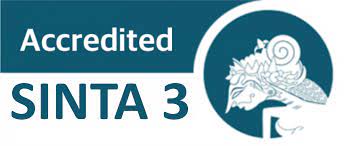Improving Problem-Solving Student Ability: Integrating Google Earth with SETS Model Learning for Effective Solutions
Abstract
Keywords
Full Text:
PDFReferences
Akcay, H., & Yager, R. E. (2010). The Impact of a Science/Technology/Society Teaching Approach on Student Learning in Five Domains. Journal of Science Education and Technology, 19(6), 602–611. https://doi.org/10.1007/s10956-010-9226-7
Astuti, M., & Manurung, B. (2019). The Effect Of Science, Environment, Technology, And Society (Sets) Approach Assisted By Visual Media On Critical Thinking Ability And Students’ Scientific Attitudes In The Material Of Living Creator Classification. Indonesian Science Education Research, 1(1), 26–33.
Dewi, I. N., Poedjiastoeti, S., & Prahani, B. K. (2017). ElSII Learning Model Based Local Wisdom To Improve Students’ Problem Solving Skills and Scientific Communication. International Journal of Education and Research, 5(1), 107–118.
Dia, F., Putra, A. K., & Suharto, Y. (2021). Improving Critical Thinking Ability : Earthcomm Learning For Watershed Conservation Materials. IJIS Edu : Indonesian Journal of Integrated Science Education, 3(2), 99–106.
Fatchan, A., Soekamto, H., & Yuniarti, Y. (2014). Pengaruh Model Pembelajaran Science, Environment, Technology, Society (SETS) Terhadap Kemampuan Berkomunikasi Secara Tertulis Berupa Penulisan Karya Ilmiah Bidang Geografi Siswa SMA. Jurnal Pendidikan Dan Pembelajaran (JPP), 21(1), 33–40.
Gathong, S., & Chamrat, S. (2019). The implementation of science, technology and society environment (STSE)-based learning for developing pre-service general science teachers’ understanding of the nature of science by empirical evidence. Jurnal Pendidikan IPA Indonesia, 8(3), 354–360. https://doi.org/10.15294/jpii.v8i3.19442
Goldstein, O. (2016). A project-based learning approach to teaching physics for pre-service elementary school teacher education students. Cogent Education, 3(1). https://doi.org/10.1080/2331186X.2016.1200833
Hadi, H. (2020). Penguatan Karakter Cinta Tanah Air Melalui PEMBELAJARAN GEOGRAFI ABAD 21. Jurnal Genta Mulia, XI(2), 220–232.
Hake, R. R. (1999). Analyzing Change/Gain Scores. America Educational Research Association’s Division, Measurrement and Research Methodology. https://web.physics.indiana.edu/sdi/AnalyzingChange-Gain.pdf
Imam, S. (2016). Mengoptimalisasi Hasil Belajar Geografi dengan Concept Mapping Bervisi SETS pada Siswa Kelas XI IPS.2 SMAN 1 Warureja Kabupaten Tegal. Penelitian Dan Wacana Pendidikan, 10(1), 50–67.
Khasanah, N. (2013). SETS ( Science , Environmental , Technology and Society ) sebagai Pendekatan Pembelajaran IPA Modern pada Kurikulum 2013. Seminar Nasional Konservasi Dan Pemanfaatan Sumber Daya Alam, FKIP UNS, 1(1), 270–277.
Kidman, G. (2018). Getting to the Root of the Problem in Experiential Learning: Using Problem Solving and Collective Reflection to Improve Learning Outcomes. Global Comparative Education: Journal of the WCCES, 2(2), 49–61.
Lynn, S. (2012). Using web-based GIS and virtual globes in undergraduate education. In et al David, J.Unwin. (Ed.), Teaching Geographic Information Science and Technology in Higher Education (1st ed., pp. 290–299). John Wiley & Sons, Ltd.
Maimunah. (2017). the Use of Science Environment Technology and Society (Sets) Learning Model for Enhancing the Critical Thinking Skills and Scientific Attitudes. Jurnal Penelitian Dan Pembelajaran Ipa, 3(1), 65–73.
Maimunah, M. (2016). Penggunaan Model Pembelajaran Science Environment Technology and Society (Sets) untuk Meningkatkan Kemampuan Berpikir Kritis dan Sikap Ilmiah. Jurnal Ilmiah Pendidikan MIPA, 6(2), 134–140. https://doi.org/10.30998/formatif.v6i2.947
MaKinster, J., Trautmann, N., & Barnett, M. (2014). Teaching science and investigating environmental issues with geospatial technology: Designing effective professional development for teachers. Teaching Science and Investigating Environmental Issues with Geospatial Technology: Designing Effective Professional Development for Teachers, 1–353. https://doi.org/10.1007/978-90-481-3931-6
Martins, P., Noga, B., Maris, L., & Ritter, O. (2021). Connecting environmental education , science – technology – society and ecological theory : possible pathways to reduce socioenvironmental problems. Brazilian Journal of Environmental Sciences, 56(1), 491–500.
Miller, R. J., & Maellaro, R. (2016). Getting to the Root of the Problem in Experiential Learning: Using Problem Solving and Collective Reflection to Improve Learning Outcomes. Journal of Management Education, 40(2), 170–193. https://doi.org/10.1177/1052562915623822
Minarti, I. B., Susilowati, S. M. E., & Indriyanti, D. R. (2012). Perangkat Pembelajaran Ipa Terpadu Bervisi Sets Berbasis Edutainment Pada Tema Pencernaan. Journal of Innovative Science Education, 1(2), 7. http://journal.unnes.ac.id/sju/index.php/jise
Muslimin, S., Sugiarti, I. Y., Febianti, Y. N., & Putri, D. P. (2019). The Implementation of SETS (Science, Environment, Technology, and Society) Approach Through Flood Natural Disaster Mitigation. International Educational Research, 2(1), 6–13.
Nayazik, Akhmad, et al. (2013). Peningkatan karakter dan pemecahan masalah melalui pembelajaran ideal problem solving-pemrosesan informasi. Unnes Journal of Mathematics Education Research, 2(2). http://journal.unnes.ac.id/sju/index.php/ujmer
Nurkhasanah, A., Ibrahim, M., & Widodo, W. (2019). Use of SETS ( Science , Environment , Technology and Society ) Approach for Practice the Problem Solving Ability of Elementary School Students in Surabaya. International Journal of Innovative Science and Research Technology ISSN, 4(12), 515–520.
Oktavianto, D. A. (2020). Pengembangan Model Pembelajaran Saintifik Berbasis Google Earth Untuk Meningkatkan Hasil Belajar Pemetaan Geologi. J-PIPS (Jurnal Pendidikan Ilmu Pengetahuan Sosial), 7(1), 14–27. https://doi.org/10.18860/jpips.v7i1.10353
Partayasa, W., Suharta, I. G. P., & Suparta, I. N. (2020). Pengaruh Model Creative Problem Solving (CPS) Berbantuan Video Pembelajaran Terhadap Kemampuan Pemecahan Masalah Ditinjau Dari Minat. JNPM (Jurnal Nasional Pendidikan Matematika), 4(1), 168. https://doi.org/10.33603/jnpm.v4i1.2644
Poedjiadi, A. (2005). Sains Teknologi Masyarakat: Model Pembelajaran Kontekstual Bermuatan Nilai. PT Remaja Rosdakarya.
Prastiwi, L., Sigit, D. V., & Ristanto, R. H. (2019). Relationship Between Academic Ability and Environmental Problem-Solving Skill: A Case Study at Adiwiyata Schools in Tangerang City, Indonesia. Üniversitepark Bülten, 8(1), 76–86. https://doi.org/10.22521/unibulletin.2019.81.6
Purwanto, P., Utaya, S., Handoyo, B., Bachri, S., Yulistiya, D., & Amin, S. (2021). The Spatial Thinking Ability Students on the Character of Urban and Rural Environments in Solving Population Problems. Review of International Geographical Education Online, 11(3), 636–652. https://doi.org/10.33403/rigeo.877708
Sanabria, J. C., & Arámburo-Lizárraga, J. (2017). Enhancing 21st century skills with AR: Using the gradual immersion method to develop collaborative creativity. Eurasia Journal of Mathematics, Science and Technology Education, 13(2), 487–501. https://doi.org/10.12973/eurasia.2017.00627a
Santrock, J. W. (2011). Educational Psychology. In Annual review of psychology (Vol. 4). McGraw Hill. https://doi.org/10.1146/annurev.ps.04.020153.002131
Saputro, M. N. A., & Pakpahan, P. L. (2021). Mengukur Keefektifan Teori Konstruktivisme dalam Pembelajaran. JOEAI: Journal of Education and Instruction, 4(1), 24–39.
Sugiarto, A., & Djukri, D. (2015). Pembelajaran Berbasis Sets Sebagai Upaya Meningkatkan Kreativitas Dalam Pemecahan Masalah Pencemaran Lingkungan. Jurnal Inovasi Pendidikan IPA, 1(1), 1. https://doi.org/10.21831/jipi.v1i1.4527
Sugiyono. (2015). Metode Penelitian Kuantitaif, Kualitatif, dan R&D. Alfabeta.
Sujiono, S., Handoyo, B., & Ruja, I. N. (2017). Memecahkan Masalah Geografi Melalui Problem Based Learning. Jurnal Teori Dan Praksis Pembelajaran IPS, 2(2), 66–72. https://doi.org/10.17977/um022v2i22017p072
Sumarmi. (2012). Model-Model Pembelajaran Geografi (1st ed.). Aditya Media Publishing.
Wahyudiati, D. (2016). Analisis Efektivitas Kegiatan Praktikum Sebagai Upaya Peningkatan Hasil Belajar Mahasiswa. Jurnal Tatsqif, 14(2), 143–168. https://doi.org/10.20414/jtq.v14i2.27
Widiantini, N. N. A. S., Putra, M., & Wiarta, I. W. (2017). Model Pembelajaran Sets (Science, Environment, Technology, Society) Berbantuan Virtual Lab Berpengaruh Terhadap Kompetensi Pengetahuan Ipa. Journal of Education Technology, 1(2), 141. https://doi.org/10.23887/jet.v1i2.11776
Xiang, X., & Liu, Y. (2017). Understanding ‘change’ through spatial thinking using Google Earth in secondary geography. Journal of Computer Assisted Learning, 33(1), 65–78. https://doi.org/10.1111/jcal.12166
Yoga, P., & Christina, I. (2017). Pengembangan Multimedia Pembelajaran Geografi Berbasis Memory Sport pada Materi Litosfer untuk Peserta Didik SMA. Inovasi Teknologi Pendidikan, 4(1), 97–110.
Yörük, N., Morgil, I., & Seçken, N. (2010). The effects of science, technology, society, environment (STSE) interactions on teaching chemistry. Natural Science, 02(12), 1417–1424. https://doi.org/10.4236/ns.2010.212173
DOI: https://doi.org/10.18860/abj.v8i1.19699
Refbacks
- There are currently no refbacks.
Copyright (c) 2023 Khoirunnisaa' Khoirunnisaa', Muhammad Rizieq Fahmi

This work is licensed under a Creative Commons Attribution-NonCommercial 4.0 International License.
...............................................................................................................................................................
Mailing Address:
Ruang Jurnal Abjadia, Fakultas Ilmu Tarbiyah dan Keguruan (FITK)
Universitas Islam Negeri (UIN) Maulana Malik Ibrahim Malang
Jalan Gajayana 50 Malang 65144, Jawa Timur, Indonesia
Phone/Faximile: (+62341) 552398, Cell Phone: +62 81 333 666 063
Website: http://ejournal.uin-malang.ac.id/index.php/abjadia
Email: abjadia@uin-malang.com
Abjadia: International Journal of Education. This work is licensed under a Creative Commons Attribution-ShareAlike 4.0 International License.
...............................................................................................................................................................
Indexed by:






